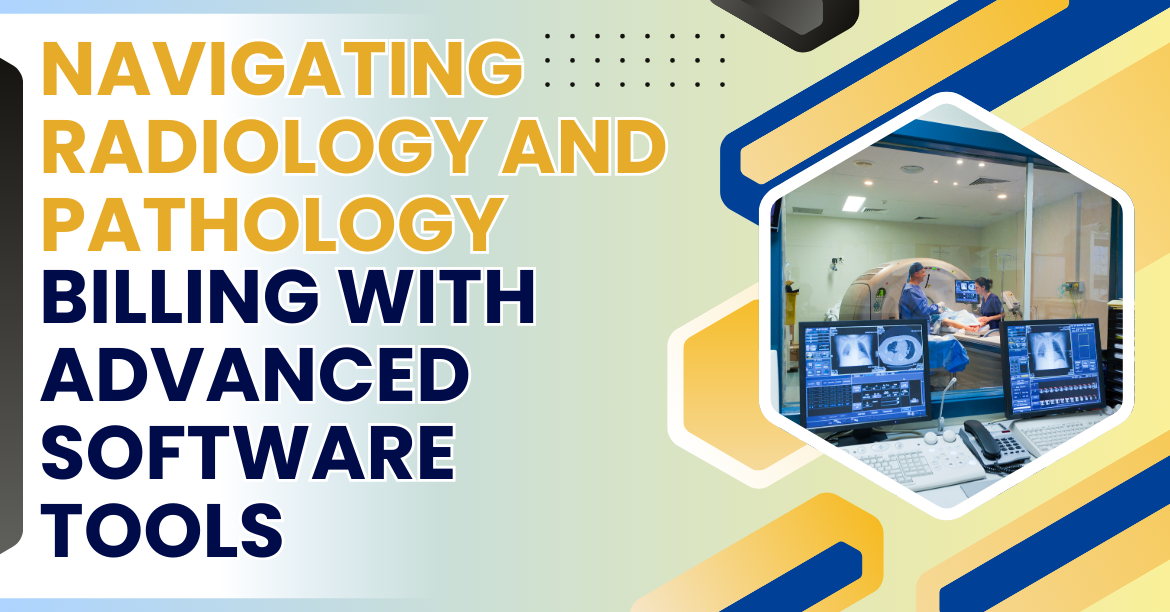


Radiology and pathology departments are essential to the diagnosis and treatment of patients in the intricate healthcare ecosystem. But because of the complicated coding requirements, the necessity for correct documentation, and the regular changes to rules, invoicing for these specialist services can be difficult. Modern software solutions have changed the game by simplifying billing procedures and guaranteeing accuracy, efficiency, and compliance.

Billing procedures for radiology and pathology are very different from those for other medical specialties. High volumes of professional and technical services are provided in these domains, and each one calls for particular coding and documentation. For example, radiology frequently blends expert interpretation with technology imaging services. Lab tests used in pathology can range from straightforward blood testing to intricate histological analyses. Challenges in both fields include:
Complex Coding: CPT and ICD codes for radiology and pathology require precise application to avoid claim denials.
Regulatory Compliance: Adhering to HIPAA, Medicare, and insurance policies is non-negotiable.
High Claim Volume: The sheer number of services processed daily increases the chances of errors.
Integration with Other Departments: Radiology and pathology must seamlessly collaborate with referring physicians and other departments.
These issues are resolved by sophisticated billing software solutions made especially for pathology and radiology, which improve accuracy and automate procedures. This is how they contribute:
Modern billing solutions may readily connect electronic medical records (EMR) with electronic health records (EHR). This reduces discrepancies and expedites procedures by guaranteeing that billing codes, diagnostic reports, and patient data are all in sync.
The invoicing software includes eligibility verification capabilities that radiology and pathology departments can use to confirm insurance coverage prior to testing. This reduces claim denials and ensures on-time payouts.
To adhere to evolving requirements, such as Medicare guidelines and insurance policies, sophisticated tools are updated on a regular basis. This lowers the possibility of audits and fines by ensuring that claims satisfy all relevant requirements.
Billing software provides in-depth analytics, helping departments track claim statuses, identify trends in denials, and optimize revenue cycles. Customizable dashboards and reports provide actionable insights for continuous improvement.
When selecting advanced software tools for radiology and pathology billing, consider these essential features:
Specialized Modules: Tools designed specifically for radiology or pathology offer tailored functionalities, such as advanced imaging report integration or lab test categorization.
User-Friendly Interface: Intuitive designs enhance usability and reduce training time for staff.
AI and Automation: Artificial intelligence-powered automation simplifies repetitive tasks, such as coding, claim submission, and follow-ups.
Multi-Payer Support: Efficient handling of claims across multiple insurance providers ensures faster reimbursements.
Scalability: As your practice grows, the software should be capable of accommodating higher volumes and new services.
Increased Efficiency: Automation reduces the time spent on manual tasks, allowing staff to focus on patient care and other critical responsibilities.
Improved Accuracy: Minimized coding errors and accurate documentation lead to fewer claim denials and resubmissions.
Enhanced Revenue Cycle Management: With faster claims processing and fewer delays, healthcare facilities can optimize their cash flow and ensure steady revenue.
Regulatory Peace of Mind: Up-to-date compliance features mitigate the risk of audits and penalties.
Better Patient Experience: Efficient billing processes translate to fewer billing disputes and faster resolution of patient concerns.
Case Study 1: Radiology Practice Optimization A large radiology center implemented advanced billing software with AI-driven coding. The result? A 25% reduction in claim denials and a 15% increase in revenue within six months.
Case Study 2: Streamlining Pathology Billing A pathology lab integrated billing software with its EHR system, reducing turnaround time for claims processing by 30% and achieving a 98% first-pass claim acceptance rate.
The healthcare landscape is evolving rapidly, with increasing patient volumes and stricter regulations. Investing in advanced billing software is not just about improving processes; it’s about future-proofing your radiology and pathology departments. As technology advances, early adopters of innovative solutions are better positioned to adapt and thrive.
Navigating radiology and pathology billing no longer needs to be a daunting task. With advanced software tools, healthcare facilities can achieve higher accuracy, streamlined workflows, and optimized revenue cycles. By addressing the unique challenges of these specialized fields, such tools empower organizations to focus on what truly matters—delivering exceptional patient care.